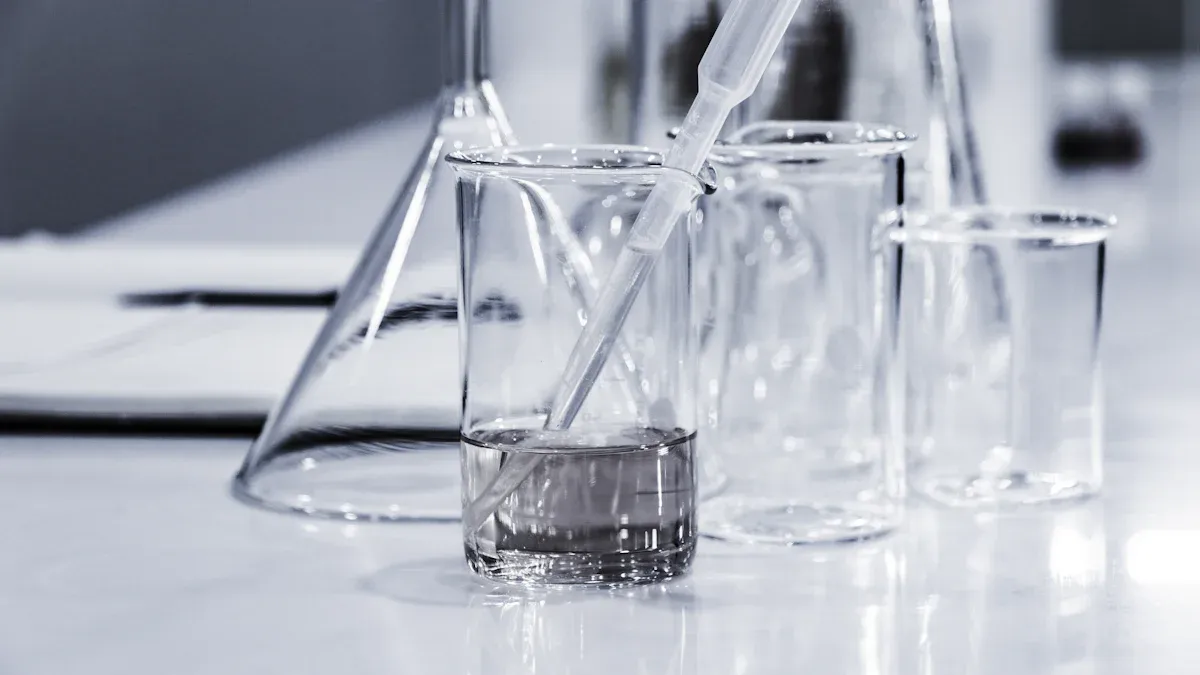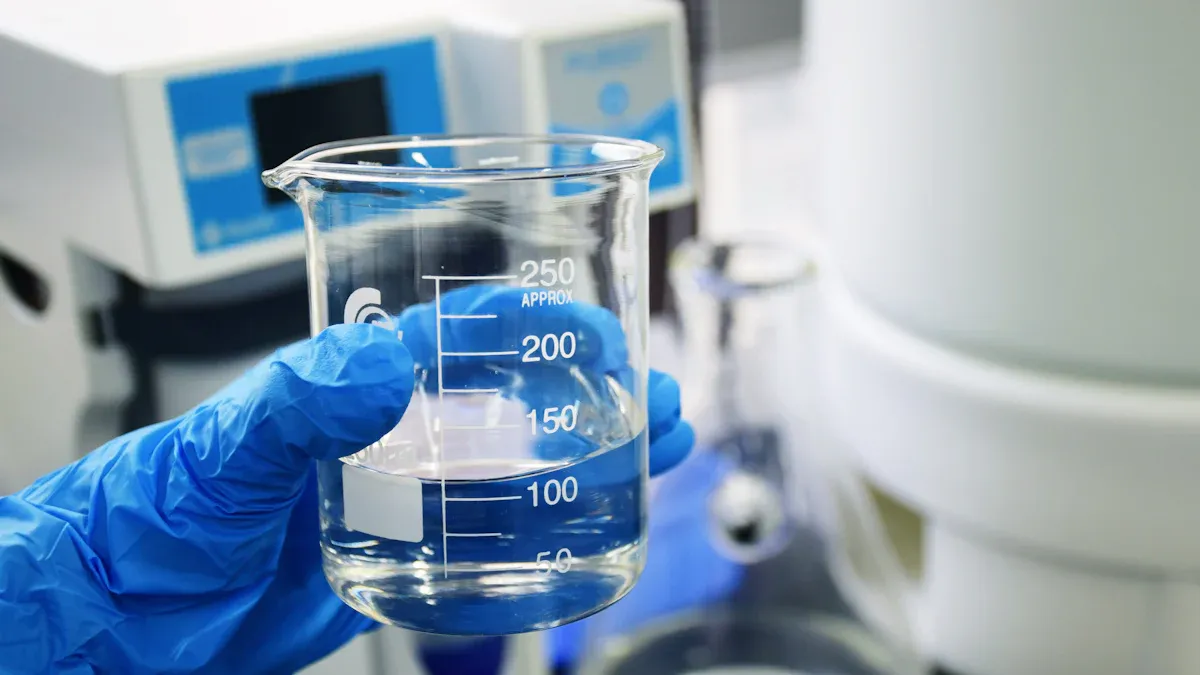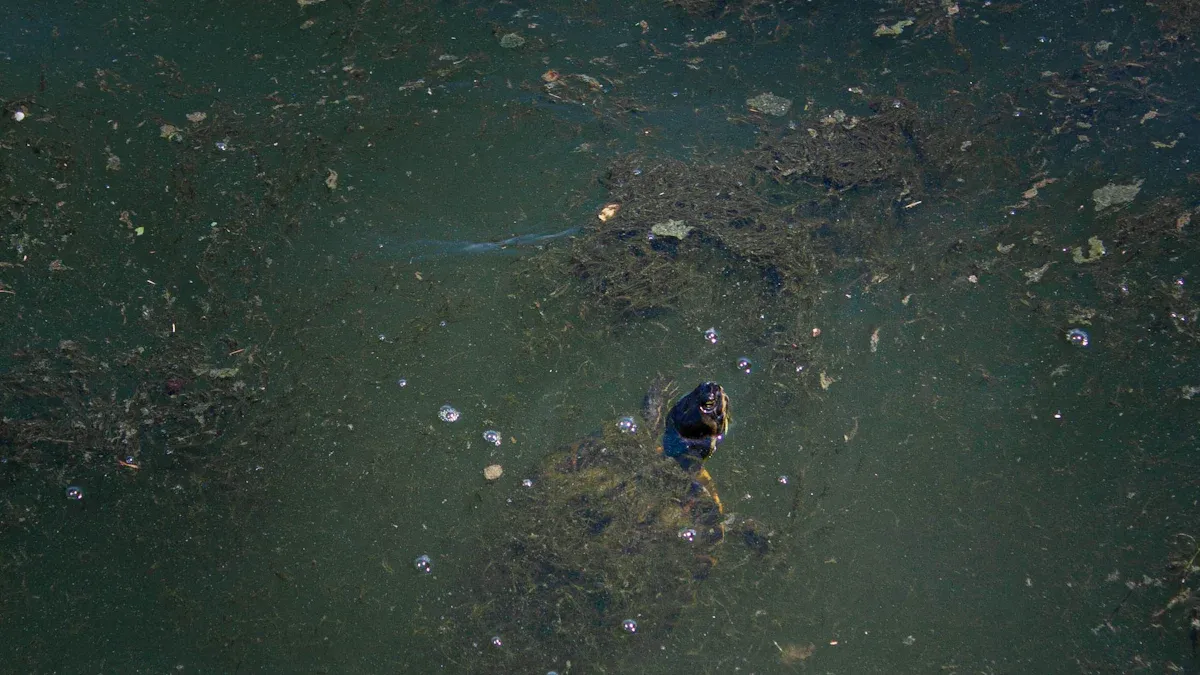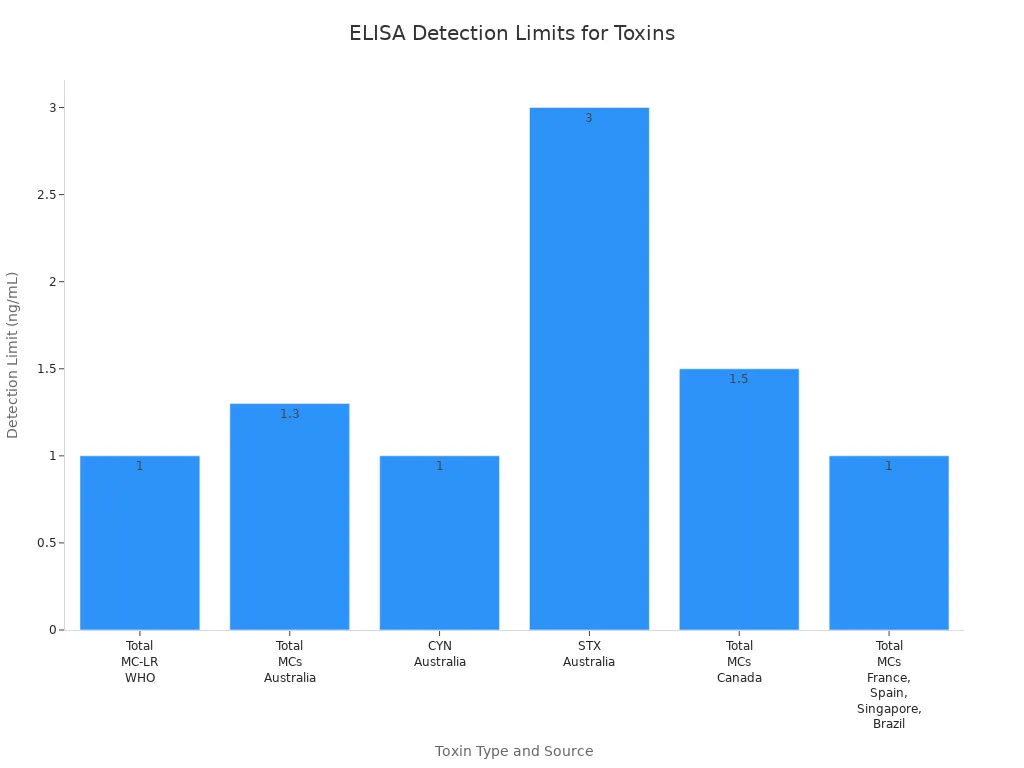News & Events
Can a Water Analysis Test Kit Really Spot Hidden Toxins?

You might wonder if a water analysis test kit using ELISA can really spot hidden toxins. The answer is yes. These kits play a big role in safeguarding drinking water and supporting environmental monitoring. When you use an ELISA-based test, you tap into a method that stands out for several reasons:
- ELISA tests are economical and reliable.
- They can find tiny amounts of toxins that other methods sometimes miss.
- Immunoassays like ELISA adapt well to different chemical and industrial uses.
Water quality monitoring matters for your health and the environment. You deserve clear answers. This guide will break down technical terms so you can understand how these tests help protect water quality and the environment.
Key Takeaways
- ELISA test kits are affordable and reliable tools for detecting hidden toxins in water, making them accessible for both home and field use.
- These kits can identify very low levels of pollutants, including heavy metals and harmful chemicals, helping you ensure safe drinking water.
- ELISA provides quick results, typically within 30 to 90 minutes, allowing for timely action if contaminants are found.
- While ELISA is effective, it is important to confirm results with additional testing methods to ensure accuracy and reliability.
- Regular water testing with ELISA kits can help protect your health and the environment by identifying potential pollution sources early.
ELISA in Water Analysis Test Kits

How ELISA Works
You might wonder how an enzyme-linked immunosorbent assay, or ELISA, helps you check for toxins in water. The process uses a special immunoassay technique that relies on antibodies and enzymes. Here is a simple breakdown of the steps in a water analysis test kit:
- The kit prepares a surface with a capture antibody.
- It blocks spots where unwanted substances could stick.
- You add your water sample. If toxins are present, they attach to the antibody.
- The kit washes away anything that does not stick.
- Another antibody, which also recognizes the toxin, is added. This creates a “sandwich” with the toxin in the middle.
- The kit adds an enzyme-linked antibody that binds to the second antibody.
- Another wash removes anything extra.
- A chemical is added. The enzyme changes this chemical, making a color or signal.
- The kit measures this signal. The strength of the signal tells you how much toxin is in your water.
This immunoassay method makes detection of even tiny amounts of toxins possible. The color change or signal is easy to see and measure, so you get clear results from your analysis.
Why Use ELISA for Water Testing
You want a water analysis test kit that is fast, reliable, and affordable. The enzyme-linked immunosorbent assay stands out for several reasons:
- Immunoassay techniques like ELISA are simple and powerful. You do not need fancy lab equipment.
- ELISA gives you results quickly. You can test water quality in the field or in a lab.
- The cost is much lower than other methods, such as LC/MS/MS.
- ELISA offers high sensitivity. It can spot toxins at very low levels, which is important for safety.
- Many scientists trust immunoassay analysis because it gives accurate, repeatable results.
ELISA-based immunoassay detection has become a trusted tool for water analysis. You can rely on it for both routine checks and emergency situations.
With an enzyme-linked immunosorbent assay, you get a balance of speed, cost-effectiveness, and sensitivity. This makes ELISA a top choice for water quality analysis and toxin detection.
Detecting Hidden Toxins in Water

Types of Toxins Found
You need to know what kinds of pollutants can hide in your water. ELISA test kits help you find many dangerous substances. These kits can spot both natural and man-made toxins. You may find pollutants from farms, factories, or even your own home. Some of the most common toxins include:
- Pesticides and herbicides from farming
- Pharmaceuticals from household products
- Heavy metals like lead, arsenic, cadmium, and copper
- Microcystins and nodularins from algae blooms
- Saxitoxin and anatoxin-a from harmful algae
ELISA kits work well for the detection of lead and other metals. You may see these metals in both city and rural water supplies. Lead in water is a big concern because it can cause health problems, especially for children. The detection of lead and other metals helps you avoid risks from environmental pollution from heavy metals.
Here is a table showing which toxins ELISA can detect and the method used:
| Toxin Type | Detection Method |
|---|---|
| Microcystins/Nodularins | ADDA-ELISA |
| Saxitoxin | ELISA |
| Anatoxin-a | ELISA |
| Cylindrospermopsin | LC-MS/MS |
You may also hear about “forever chemicals.” These pollutants do not break down in the environment. They build up in your body over time. ELISA kits help you track these hidden threats and protect your health.
Tip: Always check your water for metals and other pollutants, even if it looks clean. Pollution can happen without any warning signs.
Sensitivity and Detection Limits
You want to know how well ELISA kits can find low levels of toxins. The detection of lead and other metals at very small amounts is important for safety. ELISA kits can spot pollutants at levels as low as 0.10 micrograms per liter (µg/L). Some new kits can even detect microcystins at 0.016 µg/L. This high sensitivity means you can catch contamination before it becomes a big problem.
Here is a chart that shows the detection limits for different toxins in water using ELISA. These limits come from trusted sources like the World Health Organization and national agencies:

You can see that ELISA kits meet strict safety standards. For example, the detection of lead and other metals often matches or beats the limits set by health agencies. This makes ELISA a strong choice for finding pollution in water.
ELISA kits also help you track metals that come from environmental pollution from heavy metals. These metals can enter water from old pipes, factories, or farm runoff. The detection of lead, arsenic, cadmium, and copper is key to keeping your water safe.
You may wonder why sensitivity matters. If a test cannot find low levels of metals, you might miss early signs of contamination. ELISA kits give you peace of mind by finding even tiny amounts of pollutants.
Note: The detection of lead and other metals in water is not just about safety. It also helps you follow local and global rules for clean water.
ELISA kits give you a simple way to check for metals, toxins, and other pollutants. You can use them at home, on the farm, or in a lab. The detection of lead and other metals helps you stop pollution before it harms your family or your community.
Accuracy and Reliability in Environmental Monitoring
Sensitivity and Specificity
When you use ELISA for water quality analysis, you want to know how well it can tell different toxins apart. Sensitivity means the test can find even small amounts of a toxin. Specificity means the test can tell one toxin from another. ELISA stands out in both areas, which is why many people trust it for environmental monitoring.
You can see how ELISA works with different toxins by looking at these points:
- ELISA tests can tell the difference between Shiga toxin 1 (Stx1) and Shiga toxin 2 (Stx2).
- The tests can also spot nine out of ten subtypes of these toxins.
- This high specificity helps you avoid confusion between similar toxins in your water.
You need this level of detail when you check for lead and other harmful substances. If a test cannot tell the difference, you might get the wrong results. ELISA gives you a clear answer, which helps you make better decisions about water quality and safety.
However, you should know that no test is perfect. ELISA can sometimes give false positives or false negatives. A false positive means the test says a toxin is present when it is not. A false negative means the test misses a toxin that is actually there. Here are some numbers from real studies:
- False negative rates for ELISA range from 4.0% to 8.0%.
- False positive rates for ELISA range from 2.7% to 13.3%.
- At a concentration of 1000 ng/kg, the false positive rate is 6.7%, and the false negative rate is 8.0%.
These numbers show that ELISA is reliable for most water analysis tasks, but you should always confirm important results, especially when you check for lead or other dangerous toxins.
Tip: Always use ELISA as part of a full water quality assessment. If you get a positive result for lead, follow up with another method to be sure.
Real-World Performance
You want to know how ELISA performs outside the lab. In real-world environmental monitoring, many factors can affect your results. ELISA works best when you use it for routine checks or quick screening of water samples. You can use it to spot lead, pesticides, and other toxins before they become a bigger problem.
Agencies like the USEPA have validated ELISA for certain water quality tests. This means you can trust the results for many common toxins, including lead. ELISA helps you keep up with strict safety standards in your community and the environment.
Still, you should understand some limits of ELISA in water analysis:
| Limitation Type | Description |
|---|---|
| Cross-reactivity | ELISA may show different responses to various microcystin types, which can lead to wrong measurements. |
| Semi-quantitative nature | ELISA gives a single signal for overall concentration, which may not show the true toxicity of all types. |
| Matrix effects | Other substances in water can change the results, making toxins look higher or lower than they are. |
| False positives | Some ELISA kits may give more false positives compared to advanced methods like LC-MS/MS. |
| Inaccessibility | ELISA may not find toxins that are bound to proteins or hidden from the test antibodies. |
You should also keep these points in mind:
- Some ELISA kits are used without checking their performance first, which can lead to bad results.
- Differences in water samples, like pH or other chemicals, can change how ELISA works.
- Results from ELISA and other methods, such as HPLC or LC-MS, do not always match. This can make it hard to confirm your findings.
You can get the best results by using ELISA as a first step in your water quality assessment. If you find lead or another toxin, use a second method to confirm. This approach helps you protect your health and the environment.
Note: ELISA gives you a fast and easy way to check water quality, but always remember its limits. Combine it with other tests for the most accurate environmental monitoring.
Practical Use in Environmental Monitoring
Applications and Benefits
You can use a water analysis test kit with ELISA technology in many real-life situations. These kits help you check water for toxins and pollution, both in the field and in the lab. Here are some examples of how you might use them:
- The SensioScreen® TR500 water analysis test kit uses ELISA to detect triazine herbicides in water. You can use it in the field to find atrazine at levels below 10 μg/l. This helps you meet safety rules in the USA and Europe.
- You can test water samples for lead and other toxins after a spill or during routine checks. ELISA kits give you fast results, so you can act quickly if you find a problem.
- In the lab, you can use ELISA-based water analysis test kits to check samples for mycotoxins, antibiotics, pesticides, and drug residues. This helps you keep water safe for drinking and farming.
ELISA kits offer many benefits for environmental monitoring. You can see these advantages in the table below:
| Benefit | Description |
|---|---|
| Simplicity | You need only basic training to use the kit and test samples. |
| Fast Processing | You can test many samples quickly, which helps when you have lots of water to check. |
| Cost-Effectiveness | You save money because you do not need expensive machines for detection or quantitative analysis. |
| Quick Results | You get answers in 30-90 minutes, so you can make decisions fast. |
| Quantitative Capability | You can measure pollution levels and get accurate numbers for lead and other toxins. |
ELISA kits help you respond to environmental emergencies. You can detect toxins from harmful algal blooms and lead in water samples quickly. This lets you protect your community and meet safety standards.
Challenges and Limitations
You may face some challenges when you use a water analysis test kit with ELISA for environmental monitoring. Sometimes, you need extra methods to confirm your results. Here are some common issues:
- ELISA kits need careful sample preparation. You must follow each step to get reliable detection of lead and other toxins.
- Some water samples contain substances that can change the test results. These matrix effects may make detection harder.
- ELISA kits can give false positives or negatives. If you find lead or another toxin, you should use another method to check your results.
- You may need a lab setup for some ELISA kits. Field kits are easier to use, but they may not work for every sample or toxin.
- Compared to LFD kits, ELISA kits need more steps and expertise. LFD kits are simpler but may not handle as many samples at once.
You should use ELISA kits for screening and measuring pollution levels. For final confirmation, you can use advanced lab methods. This helps you keep water safe and meet environmental rules.
You can rely on ELISA-based test kits to spot hidden toxins in water, including lead, but you should know their limits. To get the best results in monitoring, experts recommend:
- Use in-house and external quality checks.
- Train staff well and service equipment often.
You should also understand that ELISA tests may give higher readings than other methods and sometimes cannot measure exact amounts. New advances, like automation and nanotechnology, will make these kits even better.
| Advancement Type | Benefits |
|---|---|
| Automation | More reliable and faster results |
| Nanotechnology | Better detection of small contaminants |
Always learn both the strengths and weaknesses of ELISA before you trust your results.
FAQ
How accurate are ELISA water test kits?
ELISA kits give you reliable results for most toxins. Studies show false positive rates from 2.7% to 13.3%. You should confirm important results with another method for the best accuracy.
Can you use ELISA kits at home?
You can use some ELISA kits at home. These kits come with clear instructions. You may need basic training for best results. Always follow the steps closely.
What toxins can ELISA kits detect in water?
ELISA kits can find pesticides, herbicides, heavy metals like lead, and toxins from algae. Some kits also detect pharmaceuticals. Always check the kit label for a list of detectable toxins.
How fast do ELISA kits give results?
Most ELISA kits give you results in 30 to 90 minutes. This speed helps you act quickly if you find a problem in your water.
Do ELISA kits replace lab testing?
ELISA kits work well for screening and routine checks. For final confirmation, you should use advanced lab methods like LC-MS/MS. This approach gives you the most reliable results.

